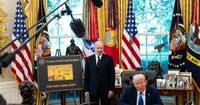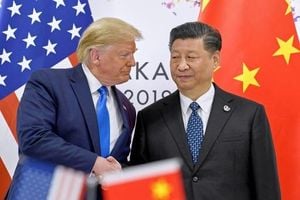On Friday, September 19, 2025, President Donald Trump signed a sweeping executive order that will dramatically reshape the landscape for skilled foreign workers seeking employment in the United States. The order, which takes effect at 12:01 a.m. ET on September 21, introduces a staggering $100,000 application fee for new H-1B visa applicants—a move that has already sent shockwaves through the technology sector and raised questions across the global business community.
The H-1B program, established in 1990, was designed to help American employers fill specialized roles—think engineers, scientists, and IT professionals—when qualified domestic candidates couldn’t be found. Over the decades, it has become a lifeline for Silicon Valley giants and a pathway for global talent to contribute to the U.S. economy. But now, with a single presidential signature, the cost of accessing this talent pool has skyrocketed.
According to Business Insider, the new fee will only apply to new applicants starting with the H-1B lottery cycle in March 2026. The White House clarified on September 20 that current H-1B visa holders, including those currently outside the country, will not be charged the new fee to re-enter the United States. "H-1B visa holders can leave and re-enter the country to the same extent as they normally would; whatever ability they have to do that is not impacted by yesterday's proclamation," White House press secretary Karoline Leavitt posted on X (formerly Twitter).
The announcement, however, was not without confusion. Commerce Secretary Howard Lutnick initially stated that the $100,000 fee would be paid annually by employers, but Leavitt later clarified it would be a one-time payment. The U.S. Citizenship and Immigration Services (USCIS) echoed this, confirming in a memo on September 20 that the fee applies only to new applicants and not to renewals or current visa holders.
For tech titans like Amazon, Google, Meta, Microsoft, Apple, and IBM—companies that collectively sponsor tens of thousands of H-1B workers each year—the change is monumental. Amazon alone had 14,783 certified H-1B filings as of March 2025, according to Business Insider. The technology sector, which accounts for nearly half of all H-1B applications, is expected to be hit particularly hard by the new fee structure.
President Trump’s rationale for the fee is rooted in concerns about abuse of the H-1B program. In his proclamation, he argued, "Some employers, using practices now widely adopted by entire sectors, have abused the H-1B statute and its regulations to artificially suppress wages, resulting in a disadvantageous labour market for American citizens, while at the same time making it more difficult to attract and retain the highest skilled subset of temporary workers, with the largest impact seen in critical science, technology, engineering and math (STEM) fields." Trump cited figures showing that the number of foreign STEM workers more than doubled from 1.2 million in 2000 to almost 2.5 million in 2019, while overall STEM employment grew by only 44.5 percent in that period.
Commerce Secretary Lutnick was blunt about the administration’s intentions. “The whole idea is, no more will these big tech companies or other companies train foreign workers,” Lutnick said, as reported by The New York Times. “They have to pay the government $100,000, then they have to pay the employee — so it’s just not economic. If you’re going to train somebody, you’re going to train one of the recent graduates from one of the great universities across our land.”
The H-1B program has always been a lightning rod for political debate. Supporters argue it’s essential for maintaining America’s edge in innovation and competitiveness, especially as the demand for highly skilled tech workers continues to outpace domestic supply. Elon Musk, himself a former H-1B holder, summed up the pro-immigration tech perspective late last year: “The number of people who are super-talented engineers and super motivated in the USA is far too low. If you want our team to win the championship, you need to recruit top talent, whatever they be.” Vivek Ramaswamy, a biotech entrepreneur, echoed this sentiment, warning that American culture "had venerated mediocrity over excellence" and thus could not produce the best engineering talent needed.
On the other side, critics—many aligned with Trump’s hardline immigration stance—insist that the program is too often used to replace American workers with cheaper foreign labor. They point to high-profile cases, such as the 2015 layoffs at Walt Disney World, where American employees were reportedly required to train their H-1B replacements. The Economic Policy Institute has highlighted that about 60 percent of H-1B positions in 2019 paid “well below” the local median wage for the occupation, despite legal requirements that employers pay at least the prevailing wage.
Legally, the Department of Labor mandates that employers pay H-1B workers at least equal to the actual wage paid to similarly qualified U.S. workers or the prevailing wage for the occupation in the area—whichever is greater. Salaries for H-1B workers vary widely: about 30% earn $100,000 or less annually, while nearly 10% make over $200,000, according to Department of Labor data.
The annual cap for H-1B visas stands at 65,000 for workers with bachelor’s degrees and 20,000 for those with advanced degrees from U.S. institutions. Universities and research organizations are exempt from these caps. There is no per-country cap, but the vast majority of recipients—between two-thirds and just over three-quarters—come from India. This has not gone unnoticed in New Delhi, where India’s Ministry of External Affairs voiced concern that abrupt changes could have “humanitarian consequences” for families, many of whom have built lives in the U.S. over decades.
For those already holding H-1B visas, the immediate impact appears limited. Reports from India indicated that lawyers were advising H-1B holders and their families abroad to return to the U.S. before the rule change took effect, but the White House and USCIS have since assured that current holders will not be affected by the new fee. Still, the uncertainty sparked a flurry of memos from tech companies, urging employees to avoid international travel or to return promptly.
In a parallel move, Trump also announced a new “gold card” visa scheme, allowing wealthy individuals to obtain U.S. residency by paying $1 million, or $2 million if sponsored by a company. This initiative, which will initially offer 80,000 slots, is pitched as a way to attract "extraordinary people at the very top," according to Lutnick, and is seen as part of a broader reshaping of U.S. immigration priorities.
Whether the $100,000 H-1B fee will survive expected legal challenges remains to be seen. For now, however, the message from the Trump administration is clear: the era of relatively affordable access to America’s skilled workforce is over, and the world’s brightest minds—and their would-be employers—will have to pay dearly for the privilege of working in the United States.
As the dust settles, companies, workers, and policymakers alike are left to grapple with the implications of a seismic shift in America’s approach to high-skilled immigration—a change that will reverberate from Silicon Valley to Bangalore and beyond.




